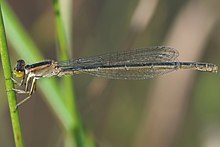Ischnura senegalensis
| Ischnura senegalensis | |
|---|---|

| |
| male | |

| |
| female | |
| Scientific classification | |
| Kingdom: | Animalia |
| Phylum: | Arthropoda |
| Class: | Insecta |
| Order: | Odonata |
| Suborder: | Zygoptera |
| Family: | Coenagrionidae |
| Genus: | Ischnura |
| Species: | I. senegalensis
|
| Binomial name | |
| Ischnura senegalensis (Rambur, 1842)
| |
| Synonyms | |
| |
Ischnura senegalensis,[2][1] also known variously as common bluetail,[3] marsh bluetail,[3] ubiquitous bluetail, African bluetail, and Senegal golden dartlet,[3][4] is a widespread damselfly of the family Coenagrionidae. It is native from Africa, through the Middle East, to southern and eastern Asia.[1][5]
Description and habitat[]
It is a small damselfly with black capped bluish green eyes. Its thorax is black on dorsum and greenish blue on the sides. Its abdomen is black on dorsum up to segment 7. Segments 1 and 2 are greenish blue and 3 to 7 are khaki yellow on the sides. Segments 8 and 9 are azure blue, with 9 black on dorsum. Segment 10 is black on dorsum and khaki yellow on the sides. The green on thorax and abdomen may turn to blue in both male and female when aged.[6]
The females of this species exhibit sexual mimicry. One group mimics the males’ colour (androchromes). Other group will have their own female colouration (gynochromes). Androchrom female looks exactly like the male except in sexual characteristics. In gynochrome, the eyes are olive green with orange above. Sides of the thorax is mud colored, will pale when matured. All the abdominal segments are marked with black on dorsum. The lateral sides are khaki yellow. Segments 1-2 and 8-10 have orage color laterally, will fade when matured.[6]
It breeds in marshes, weedy ponds and wetlands.[6][7][8][3][4]

Female with blue thorax (androchrome)

Female with green thorax (androchrome)

Female (gynochrome, sub-adult)

Mating pair

Oviposition (gynochrome female)

Oviposition (androchrome female)
See also[]
- List of odonates of India
- List of odonates of Sri Lanka
- List of odonata of Kerala
References[]
- ^ a b c Sharma, G.; Clausnitzer, V. (2016). "Ischnura senegalensis". IUCN Red List of Threatened Species. 2016: e.T59897A75436136. doi:10.2305/IUCN.UK.2016-3.RLTS.T59897A75436136.en. Retrieved 20 November 2021.
- ^ Martin Schorr; Dennis Paulson. "World Odonata List". University of Puget Sound. Retrieved 12 Oct 2018.
- ^ a b c d "Ischnura senegalensis Rambur, 1842". India Biodiversity Portal. Retrieved 2017-03-03.
- ^ a b "Ischnura senegalensis Rambur, 1842". Odonata of India, v. 1.00. Indian Foundation for Butterflies. Retrieved 2017-03-03.
- ^ K.A., Subramanian; K.G., Emiliyamma; R., Babu; C., Radhakrishnan; S.S., Talmale (2018). Atlas of Odonata (Insecta) of the Western Ghats, India. Zoological Survey of India. pp. 163–164. ISBN 9788181714954.
- ^ a b c C FC Lt. Fraser (1933). The Fauna of British India, including Ceylon and Burma, Odonata Vol. I. Red Lion Court, Fleet Street, London: Taylor and Francis. pp. 348-351.
- ^ C FC Lt. Fraser (1924). A Survey of the Odonate (Dragonfly) Fauna of Western India and Descriptions of Thirty New Species (PDF). pp. 489–490.
- ^ Subramanian, K. A. (2005). Dragonflies and Damselflies of Peninsular India - A Field Guide.
External links[]
![]() Data related to Ischnura senegalensis at Wikispecies
Data related to Ischnura senegalensis at Wikispecies
![]() Media related to Ischnura senegalensis at Wikimedia Commons
Media related to Ischnura senegalensis at Wikimedia Commons
- IUCN Red List least concern species
- Ischnura
- Odonata of Africa
- Insects described in 1842
- Taxa named by Jules Pierre Rambur
- Coenagrionidae stubs






